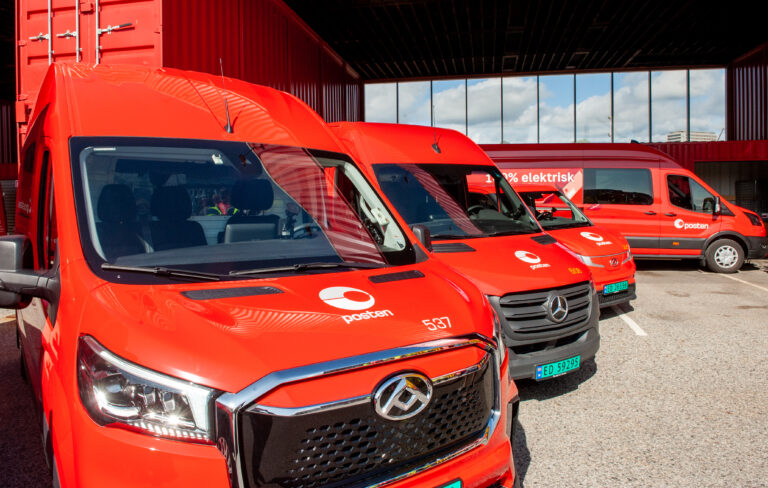As sustainability remains a key focus for postal operators around the globe, Posten Bring has announced its own ambitions with a new climate target whereby all of its vehicles will run on electricity or biogas by 2030.
The aggressive transformation of the car fleet is one of several measures that have been decided to ensure that the group’s new climate targets are met.
Commenting on the new sustainability target, Tone Wille, CEO of Posten Bring, said, “We have reduced our emissions by 55% since 2012. We have come a long way in our environmental work, but large and demanding cuts still remain. That is why we are now increasing both the pace and level of ambition in our climate work.
“Our new climate target means that in 2030 greenhouse gas emissions must be reduced by 38% from the 2022 level. We will be a driving force in the transition to a low-emission society, and with this ambitious goal and the work we have ahead of us, we are pulling the industry and society in the right direction.”
By 2040, the group must have net-zero emissions, which means that emissions must be cut by 90-95% from the 2022 level.
Substantial investments
As part of the new climate targets, Posten Bring will heavily invest in electric trucks, charging infrastructure, energy production and train transportation over the next six years. In recent years, the post has issued green bonds for Nkr3.5bn (US$334m) which are used to establish terminals that meet high environmental certification requirements and procurement of new electric vehicles. In 2021, Posten Bring was the first Nordic logistics player to issue green bonds.
Wille explained, “At the same time as we are now investing significant amounts in electric vehicles, we are building out a national charging infrastructure for heavy electric vehicles at terminals across the country in Norway. In Sweden and Denmark, we are continuing the work of installing chargers at several of our terminals. In Norway, there is a need to increase the pace of the work to establish a public charging infrastructure for heavy transport. We and the industry are completely dependent on this infrastructure to be able to adopt more heavy electric vehicles and convert to a low-emission society.”
Posten Bring will also reduce emissions by moving volumes of goods from trucks to trains. Facilities will be established at terminals that produce and increase the self-supply of renewable energy.
“In the future, we will set even stricter environmental requirements for our partners, both suppliers of transport and of goods and services. At the same time, we will help partners to reduce emissions by, among other things, being able to provide access to charging infrastructure where it is practically possible,” Wille said.
Posten Bring’s targets
Some selected measures and targets set out by Posten Bring include:
- Half of Norway’s residents now have mail and parcels delivered with electric vehicles.
- From 2026, parcels and mail will be distributed by electric van in the 60 most populous municipalities in Norway, which corresponds to 70% of the population.
- All the group’s own vehicles will run on electricity or biogas in 2030.
- Emissions from own vehicles and buildings must be reduced by 85% by 2030.
- Emissions from suppliers must be reduced by 30% by 2030.
- Work is being done to increase the car’s filling rate. Distribution routes are optimized and operations are made more efficient.
- Goods are moved from car to train. Posten Bring is today Norway’s largest user of goods on trains.
- At a number of the group’s terminals, new charging infrastructure has been established or is being built for vehicles, especially trucks and railcars, which require more specialized charging facilities.
- The group is reducing the use of aircraft.
- Facilities will be established at terminals that produce and increase the self-supply of renewable energy.
- Energy efficiency and reduced use of energy in buildings, sorting facilities and machines.
- In Denmark, all vans used must be electric by 2025.
- In Stockholm, Gothenburg and Malmö, 50% of the vans used must be electric in 2024 and 100% in 2025.
What are Science Based Targets?
In 2021, Posten Bring was the first logistics player in Norway to set climate targets (Science Based Targets) towards 2030 in line with the Paris Agreement. The Science Based Targets initiative is the world’s leading body for mandatory emission cuts.
Science-based targets are specific and measurable goals that organizations set to reduce their greenhouse gas (GHG) emissions in alignment with the scientific consensus on climate change. These targets are developed based on the latest climate science and are designed to help limit global warming.
Key features of science-based targets include:
- Alignment with global goals: Science-based targets are aligned with the latest climate science, including the Intergovernmental Panel on Climate Change (IPCC) reports and other scientific assessments. They aim to contribute to global efforts to mitigate climate change and limit its impacts.
- Ambitious and measurable: These targets are ambitious yet achievable goals for reducing GHG emissions. They are typically set over a specified timeframe and include clear metrics for measuring progress.
- Sector-specific: Science-based targets recognize that different sectors have different emissions profiles and mitigation potentials. Therefore, they may vary based on the industry and context of the organization setting the targets.
- Transparent and accountable: Organizations committing to science-based targets often publicly disclose their goals and report progress regularly. This transparency helps build accountability and trust among stakeholders.
- Verification: To ensure credibility, some organizations engage with initiatives such as the Science Based Targets initiative (SBTi), which provides guidance and independently assesses whether targets meet the criteria for scientific rigor.
For more sustainability news, click here.


